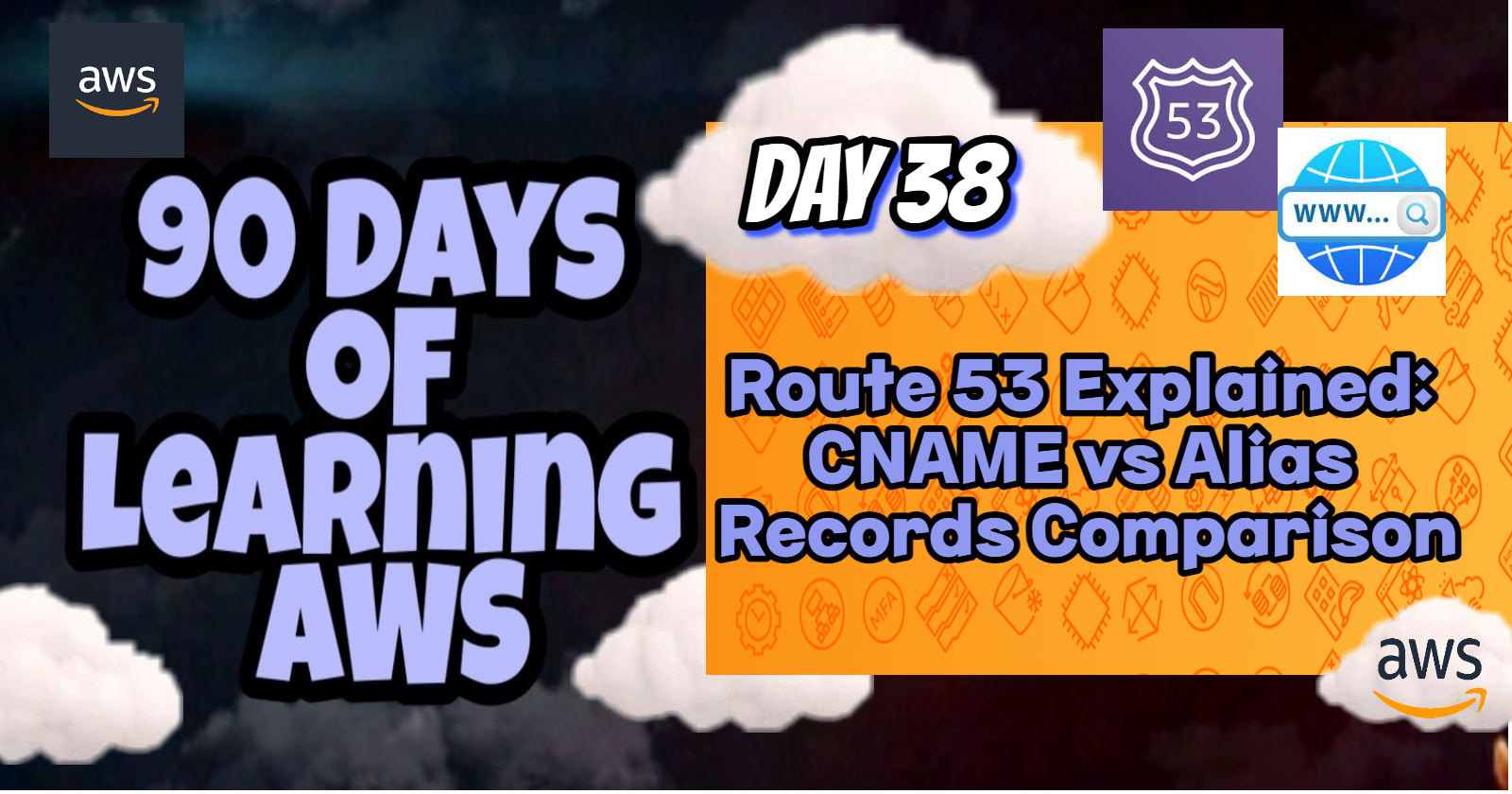Day 38: Route 53 Explained: CNAME vs Alias Records Comparison
 Shailesh
Shailesh
Introduction
Amazon Route 53 is a scalable and highly available Domain Name System (DNS) web service. In this blog post, we will dive into the differences between CNAME and Alias records in Route 53. This guide will help you understand when to use each type of record and how to configure them.
What is a CNAME Record?
A Canonical Name (CNAME) record maps an alias name to a true or canonical domain name. This means that it directs traffic from one domain to another. For example, you might map www.example.com to example.com, so when users type www.example.com in their browser, they are redirected to example.com.
Example:
makefileCopy codeName: www.example.com
Type: CNAME
Value: example.com
What is an Alias Record?
Alias records are specific to Route 53 and are similar to CNAME records but with some differences and advantages. Alias records can map a domain name to an AWS resource, such as an Amazon S3 bucket, CloudFront distribution, or another Route 53 record in the same hosted zone.
Example:
vbnetCopy codeName: example.com
Type: Alias
Value: s3-website-us-east-1.amazonaws.com
Key Differences Between CNAME and Alias Records
DNS Compatibility:
CNAME: Standard DNS record, supported by all DNS services.
Alias: Proprietary to Route 53, not a standard DNS record type.
Root Domain (Zone Apex) Usage:
CNAME: Cannot be used at the root domain (e.g., example.com) due to DNS standards.
Alias: Can be used at the root domain, making it suitable for redirecting the apex of your domain to AWS resources.
Latency and Performance:
CNAME: Results in additional DNS lookup, which might introduce slight latency.
Alias: Optimized for AWS, often resolves faster than CNAME.
Cost:
CNAME: Standard DNS lookup charges apply.
Alias: No additional cost for alias queries to AWS resources.
TTL Management:
CNAME: TTL is managed by the end user.
Alias: Inherits the TTL of the underlying AWS resource, simplifying management.
When to Use CNAME Records
Use CNAME records when:
You need to redirect one subdomain to another (e.g., www to the root domain).
You are not dealing with AWS-specific resources.
You require DNS services that are not provided by Route 53.
When to Use Alias Records
Use Alias records when:
You need to map the root domain (zone apex) to an AWS resource.
You want to benefit from the latency and performance optimizations of Route 53.
You are managing AWS-specific resources like S3 buckets or CloudFront distributions.
Step-by-Step Guide to Creating CNAME and Alias Records
Creating a CNAME Record
Open Route 53 Console: Sign in to the AWS Management Console and open the Route 53 console at AWS Route 53 Console.
Select Hosted Zone: Select the hosted zone for your domain.
Create Record Set: Click on Create record set.
Configure CNAME Record:
Name: Enter the subdomain.
Type: Select CNAME.
Value: Enter the canonical domain name.
Create Record: Click on Create to finalize.
Creating an Alias Record
Open Route 53 Console: Sign in to the AWS Management Console and open the Route 53 console at AWS Route 53 Console.
Select Hosted Zone: Select the hosted zone for your domain.
Create Record Set: Click on Create record set
Configure Alias Record:
Name: Enter the domain or subdomain.
Type: Select the type that matches the AWS resource (e.g., A or AAAA).
Alias: Choose Yes.
Alias Target: Select the AWS resource from the list.
Create Record: Click on Create to finalize.
Conclusion
Understanding the differences between CNAME and Alias records in Route 53 is crucial for effectively managing your DNS settings, especially when dealing with AWS resources. CNAME records are great for standard DNS needs, while Alias records offer powerful advantages for integrating with AWS services. 🌐🚀
Subscribe to my newsletter
Read articles from Shailesh directly inside your inbox. Subscribe to the newsletter, and don't miss out.
Written by

Shailesh
Shailesh
As a Solution Architect, I am responsible for designing and implementing scalable, secure, and efficient IT solutions. My key responsibilities include: 🔸Analysing business requirements and translating them into technical solutions. 🔸Developing comprehensive architectural plans to meet organizational goals. 🔸Ensuring seamless integration of new technologies with existing systems. 🔸Overseeing the implementation of projects to ensure alignment with design. 🔸Providing technical leadership and guidance to development teams. 🔸Conducting performance assessments and optimizing solutions for efficiency. 🔸Maintaining a keen focus on security, compliance, and best practices. Actively exploring new technologies and continuously refining strategies to drive innovation and excellence.